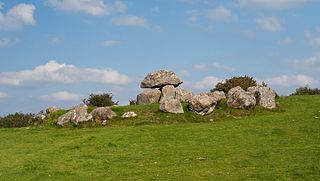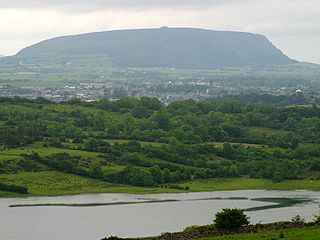
Lugh or Lug is a figure in Irish mythology. A member of the Tuatha Dé Danann, a group of supernatural beings, Lugh is portrayed as a warrior, a king, a master craftsman and a savior. He is associated with skill and mastery in multiple disciplines, including the arts. Lugh also has associations with oaths, truth and the law, and therefore with rightful kingship. Lugh is linked with the harvest festival of Lughnasadh, which bears his name. His most common epithets are Lámfada[ˈl̪ˠaːw ad̪ˠə] and Samildánach[ˈsˠawˠil d̪ˠaːnˠəxˠ].

Newgrange is a prehistoric monument in County Meath in Ireland, located on a rise overlooking the River Boyne, 8 kilometres (5.0 mi) west of Drogheda. It is an exceptionally grand passage tomb built during the Neolithic Period, around 3200 BC, making it older than Stonehenge and the Egyptian pyramids. It is aligned on the winter solstice sunrise. Newgrange is the main monument in the Brú na Bóinne complex, a World Heritage Site that also includes the passage tombs of Knowth and Dowth, as well as other henges, burial mounds and standing stones.

The court cairn or court tomb is a megalithic type of chambered cairn or gallery grave. During the period, 3900–3500 BCE, more than 390 court cairns were built in Ireland and over 100 in southwest Scotland. The Neolithic monuments are identified by an uncovered courtyard connected to one or more roofed and partitioned burial chambers. Many monuments were built in multiple phases in both Ireland and Scotland and later re-used in the Early Bronze Age.

The Mythological Cycle is a conventional grouping within Irish mythology. It consists of tales and poems about the god-like Tuatha Dé Danann, who are based on Ireland's pagan deities, and other mythical races such as the Fomorians and Fir Bolg. It is one of the four main story 'cycles' of early Irish myth and legend, along with the Ulster Cycle, the Fianna Cycle and the Cycles of the Kings. The name "Mythological Cycle" seems to have gained currency with Arbois de Jubainville c. 1881–1883. James MacKillop says the term is now "somewhat awkward", and John T. Koch notes it is "potentially misleading, in that the narratives in question represent only a small part of extant Irish mythology". He prefers T Ó Cathasaigh's name, Cycle of the Gods. Important works in the cycle are the Lebor Gabála Érenn, the Cath Maige Tuired, the Aided Chlainne Lir and Tochmarc Étaíne.

Carrowmore is a large group of megalithic monuments on the Coolera Peninsula to the west of Sligo, Ireland. They were built in the 4th millennium BC, during the Neolithic. There are thirty surviving tombs, making Carrowmore one of the largest clusters of megalithic tombs in Ireland, and one of the 'big four' along with Carrowkeel, Loughcrew and Brú na Bóinne. Carrowmore is the heart of an ancient ritual landscape which is dominated by the mountain of Knocknarea to the west. It is a protected National Monument.
Listoghil is the large central monument in the Carrowmore group of prehistoric tombs in County Sligo in Ireland. It was numbered as Carrowmore 51 by George Petrie in 1837 and this designation is still used. Although the district of Cuil Irra is steeped in legend, Listoghil has never been satisfactorily connected with the ancient legends in the way that say Newgrange has. It is the only cairn in Carrowmore. Antiquarians in the 19th century made references to another cairn nearby at Leacharail, but the site of this has never been located.

Beltra is a village in County Sligo, Ireland. Beltra is situated between the Ox Mountains and the Atlantic Ocean. There is a public house named AJ's situated near Beltra woods and Beltra Post Office. Farming, haulage and construction are the main sources of employment in Beltra. Beltra has an annual agricultural show each September.

Knocknarea is a large prominent hill west of Sligo town in County Sligo, Ireland, with a height of 327 metres (1,073 ft). Knocknarea is visually striking as it has steep limestone cliffs and stands on the Cúil Irra peninsula overlooking the Atlantic coast. At the summit is one of Ireland's largest cairns, known as Queen Maeve's Cairn, which is believed to contain a Neolithic passage tomb. In recent years there has been concern that the ancient cairn, a protected National Monument, is being damaged by climbers. There are also remains of several smaller tombs on the summit. Knocknarea overlooks the Carrowmore tombs and is thought to have been part of an ancient ritual landscape.

Clermont Carn, also known as Black Mountain, is a mountain that rises to 510 metres (1,670 ft) in the Cooley Mountains of County Louth, Ireland. It is at the border with Northern Ireland, and is also the location of the Clermont Carn transmission site. The mountain's name refers to an ancient burial cairn on its summit, and to Lord Clermont of Ravensdale.

Carrowkeel is a cluster of passage tombs in south County Sligo, Ireland. They were built in the 4th millennium BC, during the Neolithic era. The monuments are on the Bricklieve Hills, overlooking Lough Arrow, and are sometimes called the Bricklieve tombs. They are named after the townland of Carrowkeel in which most of them are located. Nearby are the Caves of Kesh and Heapstown Cairn. The Carrowkeel tombs are protected National Monuments and are considered one of the "big four" passage tomb cemeteries in Ireland, along with Carrowmore, Brú na Bóinne and Loughcrew.

The Cairn of Barnenez is a Neolithic monument located near Plouezoc'h, on the Kernéléhen peninsula in northern Finistère, Brittany (France). It dates to the early Neolithic, about 4800 BC. Along with the Tumulus of Bougon and Locmariaquer megaliths, also located in Great West France, it is one of the earliest megalithic monuments in Europe and one of the oldest man-made structures in the world. It is also remarkable for the presence of megalithic art.

Creevykeel Court Tomb is one of the finest examples of a court tomb remaining in Ireland. The monument is located in the N15 Donegal to Sligo road, 50 meters north of Creevykeel cross-roads close to Cliffoney village in County Sligo. The original name for the Creevykeel monument is Caiseal an Bhaoisgin, the Fort of Bhaoisgin, Tober an Bhaoisgin being the name of the well near the cairn. A second megalithic monument existed 300 meters to the north, but it was demolished around 1890.

Lough Arrow is a freshwater lake in the northwest of Ireland. This large, scenic lake covers an area of 12.47 square kilometres (4.8 sq mi) and lies mostly in County Sligo with a smaller part in County Roscommon. It is a popular trout fishing lake.

Mullyash Kerbed Cairn is a kerb cairn and National Monument located in County Monaghan, Ireland.
Carricknagat Megalithic Tombs are megalithic tombs and a National Monument located in County Sligo, Ireland.
Moytirra East Court Tomb, commonly called the Giant's Grave, is a court cairn and National Monument located in County Sligo, Ireland.
Cummeen Court Cairn is a court cairn and National Monument located in County Sligo, Ireland.
Ballymacgibbon Cairn is a cairn and National Monument located in County Mayo, Ireland.
Eochy's Cairn is a cairn and National Monument located in County Mayo, Ireland.

The court tomb of Behy is a megalithic monument in the townland of the same name, near Belderrig in the north of County Mayo, Ireland. The monument is located within the Céide Fields complex, 150 meters above sea level on the slope of Maumakeogh hill, and is the most westerly of the thirty or so tombs in the Killala group. The site commands wide views across the sea to the north and to the Stags of Broadhaven. The monument is located 500 meters west of the Céide Fields Visitor Centre and is on private property.














